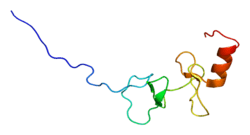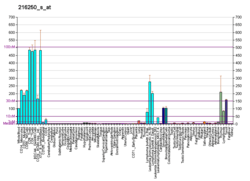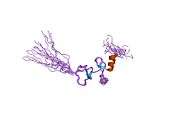LPXN
Leupaxin is a protein that in humans is encoded by the LPXN gene.[5][6]
The product encoded by this gene is preferentially expressed in hematopoietic cells and is most homologous to the focal adhesion protein, paxillin. It may function in cell type-specific signaling by associating with PYK2, a member of focal adhesion kinase family. As a substrate for a tyrosine kinase in lymphoid cells, this protein may also function in, and be regulated by tyrosine kinase activity.[6]
References
- 1 2 3 GRCh38: Ensembl release 89: ENSG00000110031 - Ensembl, May 2017
- 1 2 3 GRCm38: Ensembl release 89: ENSMUSG00000024696 - Ensembl, May 2017
- ↑ "Human PubMed Reference:".
- ↑ "Mouse PubMed Reference:".
- ↑ Lipsky BP, Beals CR, Staunton DE (Jun 1998). "Leupaxin is a novel LIM domain protein that forms a complex with PYK2". J Biol Chem. 273 (19): 11709–13. doi:10.1074/jbc.273.19.11709. PMID 9565592.
- 1 2 "Entrez Gene: LPXN leupaxin".
Further reading
- Chew V, Lam KP (2007). "Leupaxin negatively regulates B cell receptor signaling". J. Biol. Chem. 282 (37): 27181–91. doi:10.1074/jbc.M704625200. PMID 17640867.
- Sahu SN, Nunez S, Bai G, Gupta A (2007). "Interaction of Pyk2 and PTP-PEST with leupaxin in prostate cancer cells". Am. J. Physiol., Cell Physiol. 292 (6): C2288–96. doi:10.1152/ajpcell.00503.2006. PMID 17329398.
- Rual JF, Venkatesan K, Hao T, et al. (2005). "Towards a proteome-scale map of the human protein-protein interaction network". Nature. 437 (7062): 1173–8. doi:10.1038/nature04209. PMID 16189514.
- Tao WA, Wollscheid B, O'Brien R, et al. (2005). "Quantitative phosphoproteome analysis using a dendrimer conjugation chemistry and tandem mass spectrometry". Nat. Methods. 2 (8): 591–8. doi:10.1038/nmeth776. PMID 16094384.
- Watanabe N, Amano N, Ishizuka H, Mashima K (2005). "Leupaxin binds to PEST domain tyrosine phosphatase PEP". Mol. Cell. Biochem. 269 (1–2): 13–7. doi:10.1007/s11010-005-2149-6. PMID 15786712.
- Rush J, Moritz A, Lee KA, et al. (2005). "Immunoaffinity profiling of tyrosine phosphorylation in cancer cells". Nat. Biotechnol. 23 (1): 94–101. doi:10.1038/nbt1046. PMID 15592455.
- Gerhard DS, Wagner L, Feingold EA, et al. (2004). "The status, quality, and expansion of the NIH full-length cDNA project: the Mammalian Gene Collection (MGC)". Genome Res. 14 (10B): 2121–7. doi:10.1101/gr.2596504. PMC 528928. PMID 15489334.
- Brill LM, Salomon AR, Ficarro SB, et al. (2004). "Robust phosphoproteomic profiling of tyrosine phosphorylation sites from human T cells using immobilized metal affinity chromatography and tandem mass spectrometry". Anal. Chem. 76 (10): 2763–72. doi:10.1021/ac035352d. PMID 15144186.
- Gupta A, Lee BS, Khadeer MA, et al. (2003). "Leupaxin is a critical adaptor protein in the adhesion zone of the osteoclast". J. Bone Miner. Res. 18 (4): 669–85. doi:10.1359/jbmr.2003.18.4.669. PMID 12674328.
- Strausberg RL, Feingold EA, Grouse LH, et al. (2003). "Generation and initial analysis of more than 15,000 full-length human and mouse cDNA sequences". Proc. Natl. Acad. Sci. U.S.A. 99 (26): 16899–903. doi:10.1073/pnas.242603899. PMC 139241. PMID 12477932.
- Liu S, Thomas SM, Woodside DG, et al. (2000). "Binding of paxillin to alpha4 integrins modifies integrin-dependent biological responses". Nature. 402 (6762): 676–81. doi:10.1038/45264. PMID 10604475.
- Suzuki Y, Yoshitomo-Nakagawa K, Maruyama K, et al. (1997). "Construction and characterization of a full length-enriched and a 5'-end-enriched cDNA library". Gene. 200 (1–2): 149–56. doi:10.1016/S0378-1119(97)00411-3. PMID 9373149.
- Maruyama K, Sugano S (1994). "Oligo-capping: a simple method to replace the cap structure of eukaryotic mRNAs with oligoribonucleotides". Gene. 138 (1–2): 171–4. doi:10.1016/0378-1119(94)90802-8. PMID 8125298.
This article is issued from
Wikipedia.
The text is licensed under Creative Commons - Attribution - Sharealike.
Additional terms may apply for the media files.






